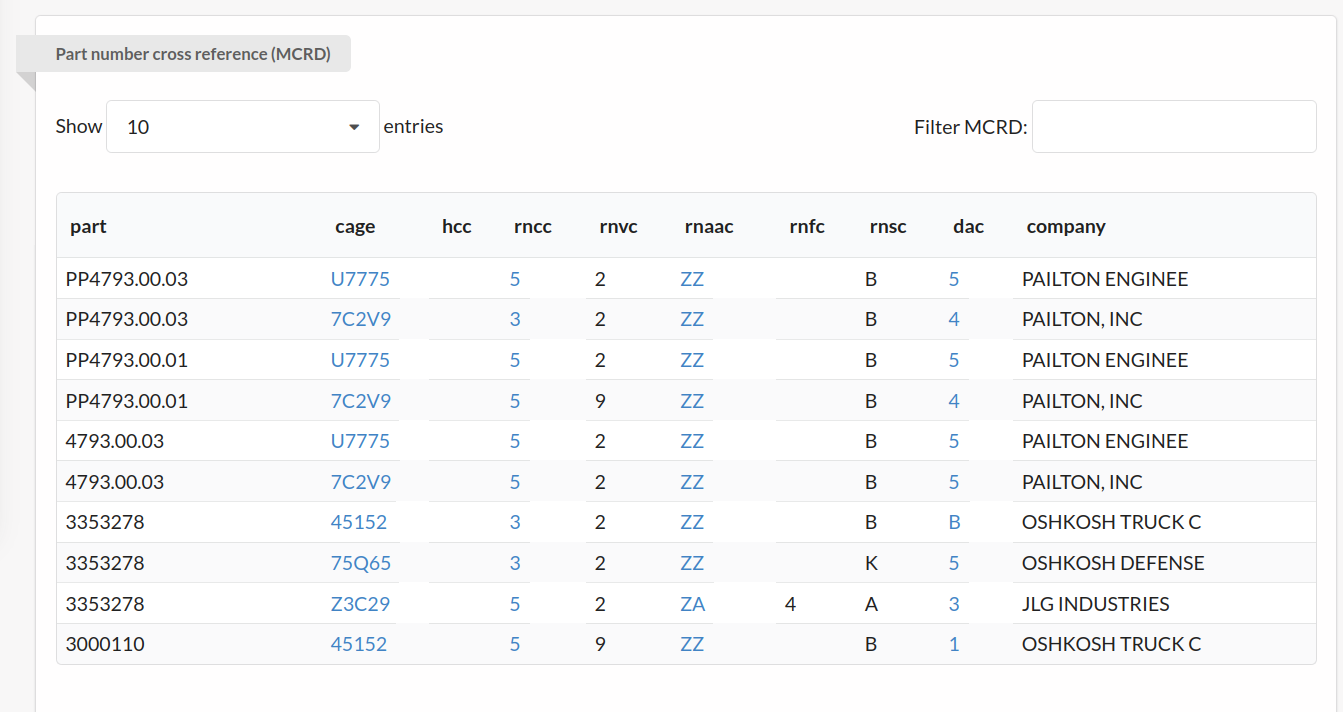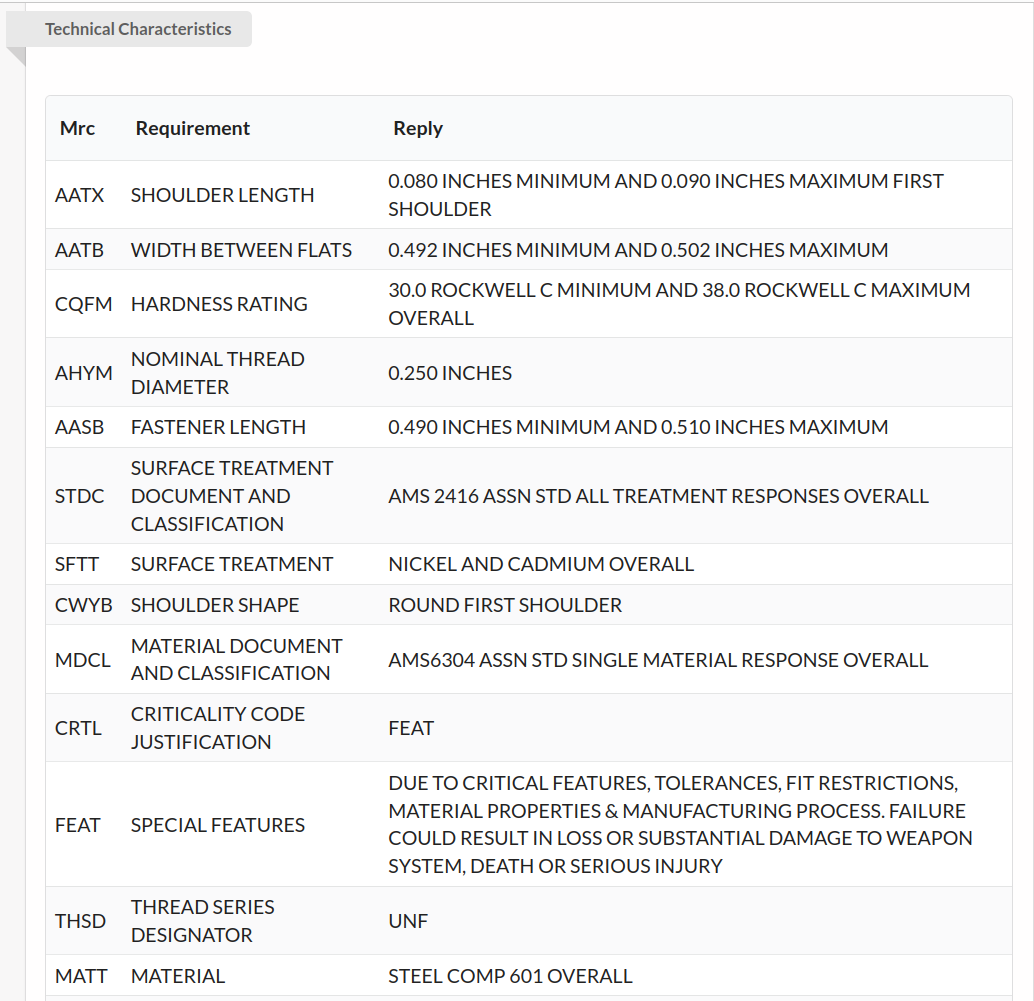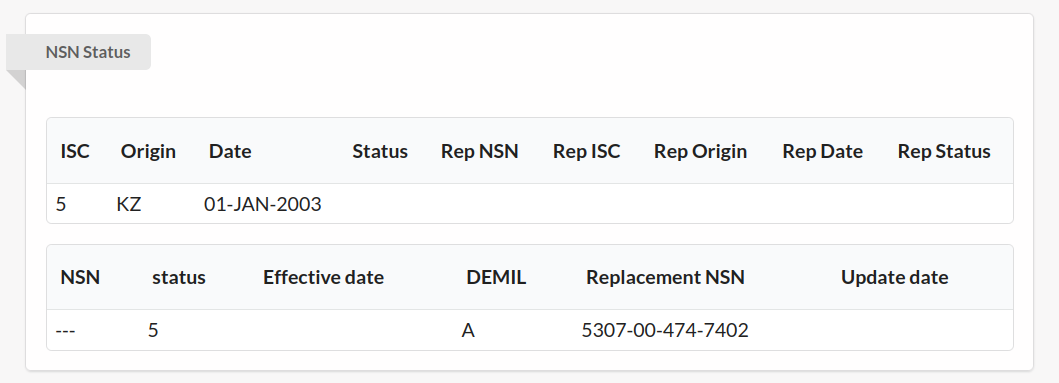FEDERAL LOGISTICS INFORMATION SYSTEM (FLIS)
Almost everything the government buys has a National Stock Number. These sixteen digit numbers are used to uniquely identify items. The FLIS is the government’s database of information relating to stock numbers. The first four digits of a stock number are the Federal Supply Class (FSC). These broad categories include hardware, gears, bearings, safety equipment, fuel, and more.

The National Item Identification Number (NIIN) represents a specific item within the Federal Supply Class. This is represented by the last nine digits of the NSN.
The government manages lots of data relating to these stock numbers. This information helps the government describe the items, determine if they are repaired or replaced, if drawings are available, and a myriad of other details that are described below:
PART NUMBER CROSS REFERENCE
This data, known as the Master Cross Reference Database (MCRD) lists the part numbers and CAGE (company) codes that are registered to sell the item to the military.

The government loves codes and acronyms, but once you learn to read this information it’s invaluable. The list of part numbers includes currently active ones as well as obsolete parts for historical purposes. Once you have looked at enough part numbers you will start to see a pattern that helps you identify the manufacturer even though the company is a distributor.
RNCC and RNVC identify the status of the item. The combination of the two values used together are called the “Item of Supply Concept”. There are only a handful of combinations that are commonly used.
| RNCC | RNVC | Description |
| 3 | 2 | Primary Reference (active) |
| 5 | 2 | Secondary Reference |
| 5 | 9 | Obsolete reference |
| 4 | 1 | Military Specification |
RNAAC tells you where the item is managed, although it almost always has a ZZ. RNFC indicates if the government has altered the manufacturer’s reference number (4 means no change).
DAC codes can indicate where drawings or technical data might be available. Some common DAC codes below:
| DAC | Description |
| 1 | RNAAC will furnish the drawing upon request |
| 3 | Drawing available to RNAAC, but they cannot furnish it |
| 4 | Technical docs other than drawing, RNAAC cannot furnish it |
| 5 | Drawing was not available to RNAAC at time of registration |
| 6 | Tech docs other than drawing, not available to RNAAC |
| B | Engineering drawing, limited use as per rights-in-data clause |
TECHNICAL CHARACTERISTICS
Every item the military catalogs includes technical characteristics which describe the item. Each characteristic has an MRC code, Requirement, and Reply. The reply column provides specific descriptive detail about each requirement.

NSN STATUS
This area provides detail on when the NSN was originally cataloged, whether or not has been subject to item standardization, its current status, and if it should be destroyed when removed from service. If the NSN has been replaced by another NSN it will be referenced here.

MLC (Management List Consolidated)
Key data points include the Major Organization Entity code (MOE), Source of Supply (SOS), DOD estimate of acquisition cost, and the effective date. The MOE is the organization that uses the item. In the chart below, DS is DLA and DF is Air Force.

PACKAGING AND FREIGHT
The military has very specific packaging and shipping requirements which must be followed. This section has a lengthy list of codes that describe if it should be waterproof, box dimensions, approximate weight, and much more. BidLink has a translation table for these codes so I won’t list them here.

MOE RULE
The most valuable information in this area are the AMC and AMSC codes, which indicate the availability of technical data, restrictions on sources of supply,

Common AMC / AMSC codes include:
| 1C | Competitive – Source approval required |
| 1G | Competitive – Complete data package available |
| 1R | Competitive – Data rights obtainment uneconomical |
| 1Z | Competitive – Commercial off-the-shelf-item |
| 2C | Competitive first time – Source approval required |
| 2G | Competitive first time – Complete data package available |
| 3C | Manufacturer – Source approval |
| 3D | Manufacturer – Data NOT available |
| 3P | Manufacturer – Data rights NOT owned |
| 3R | Manufacturer – Data rights obtainment uneconomical |
| 3Z | Manufacturer – Commercial off-the-shelf-item |
| 5D | Prime contractor – Data NOT available |
A complete translation of AMC codes is available on BidLink.
SERVICE CODES
The government also purchases services. These services do not have national stock numbers and are grouped into broad categories similar to Federal Supply Classes. The first two digits of a service code is the service group, which is an even more broad category for the service. Both are exemplified below:
| Group / Code | Description |
| H3 | Quality Control, Testing, and Inspection Services |
| H328 | INSPECTION – ENGINES, TURBINES, AND COMPONENTS |
CONCLUSION
The FLIS is part of the core data system used in defense contracting. Understanding this data gives the contractor an edge against less experienced competitors because it helps identify which items are worth pursuing.
BidLink is the original platform for finding government business which started in 1985 when we mailed floppy disks to defense contractors. Government data becomes obsolete over time, even if that information is still useful it may no longer be maintained by DOD.
Our superior search engine and vast database we’ve been building for decades has been the choice for major defense contractors including Northrop Grumman, Sikorsky Aircraft, General Dynamics, and many others. https://www.bidlink.net.
Tweet